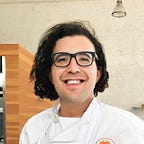Culinary School: Baking Zucchini Flan, Roasting Stuffed Chicken and Cooking Sous Vide Eggs
Awesome week in culinary school roasting a stuffed Chicken Olney, baking a Kaffir Lime Thai Panna Cotta, cooking Sous Vide eggs and doing a recipe writing workshop.
This Chicken Olney was delicious. It’s just a roasted chicken that has stuffing under the chicken’s skin. For filling we used a mixture of sautéed onions, sautéed grated zucchini, ricotta cheese, butter and chopped parsley & chives.
How to prep Chicken Olney?
- With a pair of kitchen shears cut out the backbone from a chicken. Flatten by pressing down.
- Run fingers under the skin to separate the skin from the meat. Go all the way down to the thighs.
- Take the cooled stuffing and evenly distribute it under the skin.
- Roast at 450°F for 10m then 375°F for 20–50m until white meat is temped at 145°F and dark meat is temped at 165°F.
This amazing Juniper Duck Breast was served with a side of Foie Gras Fat Potatoes. The potatoes were tossed in chopped herbs and sauteed in rendered Foie Gras fat for 15-20m.
The real interesting thing here is using compound butter in the sauce. We started off by making compound butter of finely minced juniper, liqueur, ground peppercorns, grated lemon peel and salt. We then degreased the duck breast pan and deglazed with 2:1 chicken stock : OJ until au sec. Finally we enriched with our juniper compound butter. That’s such a great way of making sure each serving of sauce gets all those great aromatics.
This Zucchini Flan is a great example of a savory dessert. We started off by sautéing shallots, garlic and grated zucchini. We then added that cooled mixture to cream, yolks, parm cheese, thyme & parsley. And finally baked off in a water bath covered on 325°F.
What’s going on in this plate?
- Center: Zucchini Flan umolded. Tastes like zucchini with a texture of soft cheese.
- All around we’ve got sauteed vegetables: zucchini, morel mushrooms and pattypan squash.
- On the edges we’ve drizzled parsley oil.
- Garnished with torn squash blossoms and cheese.
This “Thai” Panna Cotta with Coconut Tapioca, Condensed Milk Foam and coffee jelly was the perfect dessert. Let’s break down what’s going on there:
- Thai Panna Cotta: Kaffir Lime and coffee extract Panna Cotta.
- Condensed Milk Foam: Milk, cream infused with Kaffir Lime and stabilized with gelatin. We used a Siphon to foam it up.
- Coconut Tapioca: Tapioca cooked in Kaffir Lime coconut milk, cream and milk.
- Coffee Jelly: my homemade coldbrew coffee stabilized with gelatin. Cut up to tiny squares.
We made Salad Lyonnaise topped with Sous Vide Egg.
We pulled out our Polyscience Sous Vide machine and cooked our eggs in 62°C for 45m. The consistency we got from that was that of a spreadable poached eggs cooked that are evenly all the way through.
To finish the week we had a great Recipe Development workshop with Jodi Liano. We started off by writing a recipe that another culinary student will test exactly as written. It’s interesting seeing what a recipe tester does compared to your expectations of a recipe. Here are some key takeaways from that workshop:
- Don’t assume anything. Correction, assume incompetence by home cooks and malevolence by recipe testers. Break down methodology like “concasse tomatoes” to actual steps of how to core, seed and dice tomatoes.
- Before writing a recipe write down common potential pitfalls and successful flavours & textures. Keep those in mind when authoring the recipe.
- List ingredients in usage order and group them to subgroups if needed.
- Clearly identify points when home cooks can pause the recipe. e.g. “chill overnight”, “you can make this part a week in advance”, etc.
- Indicate recipe yield. e.g. “serves 6”.
- Provide clear “until” directions not just times. e.g. “Sautee onions until soft and translucent” vs. “sautee onions for 5 minutes”.
Read more about my experiences in culinary school by reading about last week’s classes:
